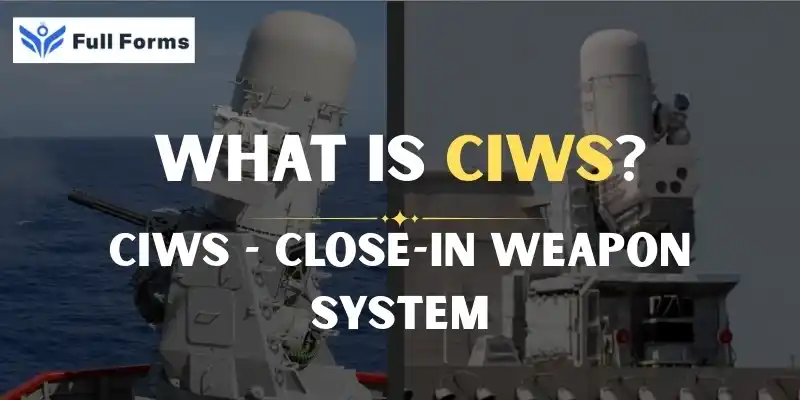Close-In Weapon System
(CIWS)

Description
Close-In Weapon System (CIWS): The Ship's Final Defense
In modern naval warfare, threats may present themselves without so much as a warning. Low-flying missiles, fast-approaching aircraft, or even swarms of drones. Warships do possess the most advanced radar systems and long-range missile defenses available but sometimes those aren’t enough. The Close-In Weapon System (CIWS) quite literally acts as a ship's last line of defense. It is an extremely powerful automated weapon that sits ready to detect and destroy threats at close range — mere seconds before they strike.
What is CIWS? A machine gun, firing at extreme rates of fire and guided by radar is mounted as a last-minute defense on naval ships against missiles attacks, aircraft, or any other threats at close range. Many know it as the "final shield" since it can engage those targets that successfully made their way past layers upon layers of other more sophisticated systems. In high threat scenarios, there is a possibility that it will play a very significant role in the protection of these assets.
These are automatic systems that can identify, follow, and shoot at an incoming target within seconds. They’re meant to work even when humans can’t react fast enough, thereby giving the warships a chance to stay afloat amidst a combat situation.
How CIWS Works
CIWS uses radar and optical sensors plus computerized fire-control systems for tracking and engaging targets. The breakdown goes into four key steps:
Detection The CIWS radar just keeps scanning all the time for any threats in the air.
Tracking As soon as a possible threat is detected, the system automatically locks onto it and keeps tracking its path.
Firing The gun fires at several thousand rounds per minute creating a very dense cloud of bullets that intercepts and destroys the target.
Assessment: The system evaluates whether or not the target has been neutralized, if not, continues firing until the threat has been eliminated or is out of range. CIWS systems are capable of functioning in auto mode, hence no human input is required. It makes them incredibly fast and responsive in a life-or-death situation. Some of the features include Rapid Firepower: Most CIWS systems can fire between 3,000 to 4,500 rounds per minute.
Short Range: It takes effect at about 1 to 2 kilometers. CIWS is really for last-minute threats that are too close for missiles to intercept.
Automatic Control: Practically from tracking to targeting and firing, it happens automatically onboard the ship.
Compact Design: Being self-contained means having radar, weaponry, and control systems all in one unit.
The versions of CIWS differ by country of origin. They have different capabilities, but essentially they serve the same purpose- close-range defense.
1. Phalanx CIWS (USA)
This is the most popular CIWS system developed by U.S. Navy consisting of 20mm M61 Vulcan Gatling gun mounted on a swiveling base. It has been deployed by the U.S. navy and allied fleets extensively. This radar can pick up small fast threats like a sea-skimming missile or even a drone.
2. Goalkeeper CIWS (Netherlands)
Designed by the Dutch, the Goalkeeper employs a 30mm Gatling gun for enhanced effect.All together it has radar and electro-optical tracking making already lethal weapon even more accurate. The most recent versions of CIWS that the Chinese Navy uses. The Type 1130 is capable of firing more than 10,000 rounds per minute in high-threat zones providing extremely dense firepower.
Significance of CIWS in Naval Defense
The main purpose of CIWS is to act as a defense against any threat that cannot be engaged by other systems in due time. In an extremely fast-paced battle environment, just a few seconds can determine survival from disaster; thus, here are the reasons why CIWS is important:
Acts as a backup when all other systems fail
Engages low-flying, stealthy threats
Gives unending 360-degree protection Works by itself when under stress As drones, and anti-ship missiles gain more use in war, CIWS makes sure ships have one last chance to guard themselves.
Drawbacks of CIWS
Though strong CIWS has its downsides: Short Range: CIWS can only take down things when they are very near. Limited Bullets: Each system holds a set number of rounds. In long attacks or group attack cases, this could be an issue.
High rates of fire mean increased wear and tear. CIWS can struggle against multiple simultaneous threats, so in most navies’ practice it forms part of a layered defense system working jointly with long-range radar, missile defense, and electronic countermeasure support.
What will happen to CIWS in the future
The CIWS changes as threats do.
We may see the following in the future:
Laser-based CIWS: It has unlimited "ammo" and can hit the target with pinpoint accuracy.
AI integration: faster decision making and better threat recognition.
Dome coverage: That means coverage from all sides at the same time. CIWS will always have a place in naval tactics, growing to meet new tech and threats.
Summary
The Close-In Weapon System is not just a large gun — it’s safety for sailors and ships, working in the smallest time gap when no other tool can assist. Quick, strong, and very smart, CIWS has found its spot as the final yet key line of defense in today’s naval fights. In a time where dangers grow faster and smarter, tools like CIWS make sure that warships are never left unguarded.
